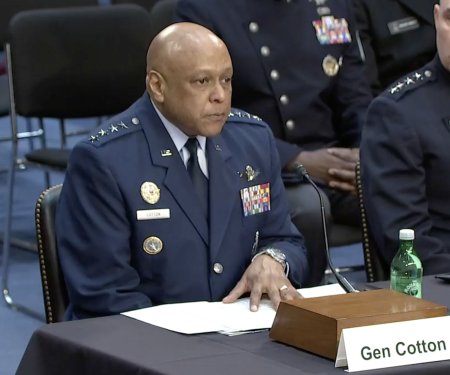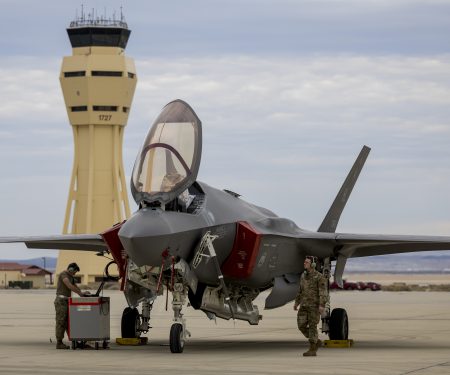Radar Sweep
Congress Passes Short-Term Funding Extension to Avert Government Shutdown
The Senate followed the House in passing a temporary extension of government funding on Feb. 29, sending the measure to President Biden's desk after a bipartisan vote that once again averts a government shutdown. The Senate voted 77 to 13 to approve the short-term extension that funds some government agencies for another week, through March 8, and others until March 22. The House passed the bill earlier in the day by a vote of 320 to 99. The president has said he will sign the legislation.
Putin Warns of Nuclear War If NATO Sends Troops to Ukraine
Russian President Vladimir Putin delivered his annual state of the nation address on Feb. 29, issuing explicit nuclear threats to the West even as he assured Russians their country could both emerge victorious from the war in Ukraine and thrive economically at home.
Brute Force: Russia ‘Doubled Down’ on Often-Crude Disinformation in 2023, Says Report
With all-out war in Ukraine entering its third brutal year, a new report says the Russian disinformation strategy online looks a lot like its battle tactics on the ground: launch wave after wave of low-skilled grunts and hope that somebody makes it through. One alarming difference on the internet, however, is artificial intelligence. While both sides have struggled to apply AI to the physical battlefield, when it comes to information war, AI translation software, AI-generated narration for videos, chatbots like ChatGPT, and the rise of generative AI overall could give Moscow an essentially limitless supply of digital cannon fodder, according to a new report from the Atlantic Council’s Digital Forensic Research Lab.
Silicon Valley’s Next Mission: Help the US Catch China and Russia in Hypersonic Weapons
The U.S. is years behind its biggest rivals in cutting-edge hypersonic missile technology. Silicon Valley is betting it can help the military catch up. Venture capitalists, better known for pumping money into business-software services and social-media apps, are now deploying hundreds of millions of dollars into developing the technology for hypersonic weapons the U.S. military wants but has struggled to figure out despite decades of trying.
Senators Warily Allow F-16 Sale to Turkey as Part of NATO Expansion Agreement
U.S. senators declined on Feb. 29 to block the sale of F-16s to Turkey, despite voicing deep disdain for Turkey’s conduct as an ally. They were upholding an unofficial bargain that Turks would get the fighter jets if they stopped blocking Sweden’s accession to NATO.
Are Your Hair and Nails in Regs? Check Out This Chart
For Airmen wondering if that shaggy haircut, their favorite eyelash extensions, or that fire engine red nail polish meet Air Force grooming standards, have no fear: The service now has a visual guide to help. The Air Force released its updated dress-and-appearance regulations Feb. 29, codifying several previously released instructions in one place while also adding visual aids to take the guesswork out of Airmen’s daily look.
Air Force Invests in New Nuclear Effects Testing Prototypes
The Air Force has tapped California-based fusion power startup Fuse Energy Technologies to deliver nuclear effects testing capabilities that are designed to advance its operators’ tactical survivability and adaptability. Broadly, nuclear weapon effects testing refers to evaluations that can gauge how objects might respond to the outputs of a nuclear weapon.
Chinese Space, Nuclear Development Is ‘Breathtakingly Fast,’ DOD Officials Warn
China’s advancements in space technology—and its nuclear triad—are proceeding with incredible speed, while Russia remains an unpredictable and dangerous threat, top officials from U.S. Strategic Command and Space Command told lawmakers Feb. 29. What “China and Russia are doing, particularly building with their counterspace weapons, they're moving breathtakingly fast,” Gen. Stephen Whiting, the head of U.S. Space Command, told the Senate Armed Services Committee.
Alaska Air Guard Unit Found to Have Rampant Pattern of Discrimination
A troubled Air National Guard unit is grappling with seemingly rampant misbehavior within its ranks, particularly among its noncommissioned officers, including sexist and racist discrimination, inappropriate jokes and a generally poor working environment. And its commander is telling the formation to shape up.
Bell, Leonardo to Partner on Tiltrotor Helicopters
Bell and Leonardo are to work together on tiltrotor helicopters, 13 years after they broke off a partnership on what was then nascent technology. The U.S. and Italian firms signed a memorandum of understanding to “evaluate cooperation opportunities in the tiltrotor technology domain,” they said in a statement Feb. 29.
Viasat Links Up with Northrop Grumman for Air Force Communications Experiment
Global communications company Viasat announced Feb. 29 it has signed an agreement with defense prime contractor Northrop Grumman to support an Air Force Research Laboratory (AFRL) experiment using broadband satellite internet to connect military vehicles and aircraft.
Pentagon's C-UAS Solutions Marketplace Seeking Innovative Counter-Drone Tech
The Counter Unmanned Aircraft Systems Solutions Marketplace, a digital acquisition platform for C-UAS innovation between government, industry and academia, is seeking hardware or software solutions to advance electro-optical/infrared technologies. One Nation Innovation, a non-profit organization comprised of former Defense Department acquisition and intelligence community professionals, posted an open call for solutions on the C-UAS Solutions Marketplace focused on procuring electro-optical/infrared technologies.
The F-111 Was Faster Than You Think
First, it’s worth recounting that the F-111, first flown in prototype form back in December 1964, was primarily intended to survive by flying fast and low. In this way, it would use its terrain-following radar to hug the ground, hopefully avoiding the worst that Warsaw Pact air defense operators had to offer, as it carried its nuclear cargo toward critical targets well behind the front lines of a potential war on Europe’s Central Front.





